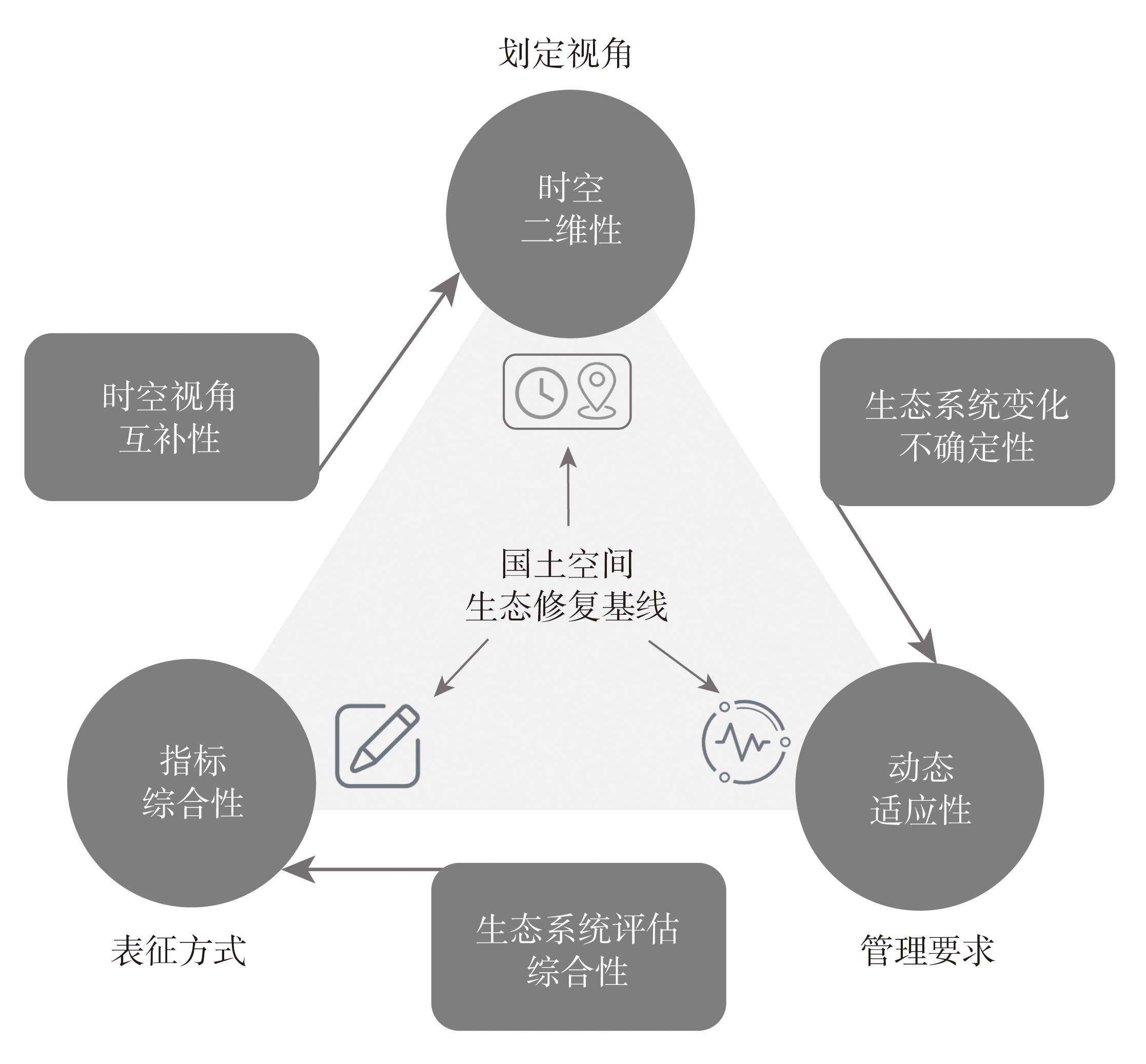

JOURNAL OF NATURAL RESOURCES >
Ecological restoration reference of terrestrial space: Theoretical recognition, identification framework and key issues
Received date: 2024-09-09
Revised date: 2024-11-06
Online published: 2024-12-16
Implementing large-scale ecological restoration of territorial space is a key strategy for China to halt ecosystem degradation and promote ecological civilization. As a reference benchmark and target guide for ecological restoration, the reference of ecological restoration is a necessary basis for the smooth implementation of ecological restoration projects. However, there is little research focusing on the ecological restoration reference of terrestrial space. Aiming to know what is ecological restoration reference, what are its characteristics, and how to identify it, in this study we discussed the definition, the identification approach framework, and the directions of future research of ecological restoration reference of territorial space. This study suggested that the reference of ecological restoration of territorial space had three basic characteristics: comprehensiveness of indicators, two-dimensionality of space and time, and dynamic adaptability. The identification framework of ecological restoration reference of territorial space includes three major steps: comprehensive ecosystem assessment, reference ecosystem selection, and reference identification under integrated spatial and temporal dimensions. With the focus on the key issues of Nature-based Solutions, integrated protection and restoration of mountains, water, forests, lakes, grasses and sands, and social-ecological system sustainability, we highlighted that ecological restoration reference identification should place great emphasis on systemic thinking, take sustainability as the core orientation for the selection of reference indicators, and pay attention to the social-ecological system integrated perspective, so as to identify ecological restoration reference based on the social-ecological process and oriented to the comprehensive enhancement of social-ecological system sustainability. This study clearly defined the conceptual connotation and identification framework of ecological restoration reference in terrestrial space, and provided theoretical and methodological support for the orderly promotion of ecological restoration projects.

TANG Hui , PENG Jian , XU Dong-mei , WU Jian-sheng . Ecological restoration reference of terrestrial space: Theoretical recognition, identification framework and key issues[J]. JOURNAL OF NATURAL RESOURCES, 2024 , 39(12) : 2768 -2782 . DOI: 10.31497/zrzyxb.20241202
| [1] |
|
| [2] |
|
| [3] |
|
| [4] |
|
| [5] |
高世昌. 国土空间生态修复的理论与方法. 中国土地, 2018, (12): 40-43.
[
|
| [6] |
|
| [7] |
易行, 白彩全, 梁龙武, 等. 国土生态修复研究的演进脉络与前沿进展. 自然资源学报, 2020, 35(1): 37-52.
[
|
| [8] |
张杨, 杨洋, 江平, 等. 山水林田湖草生命共同体的科学认知、路径及制度体系保障. 自然资源学报, 2022, 37(11): 3005-3018.
[
|
| [9] |
|
| [10] |
|
| [11] |
|
| [12] |
|
| [13] |
|
| [14] |
|
| [15] |
|
| [16] |
|
| [17] |
曹宇, 王嘉怡, 李国煜. 国土空间生态修复: 概念思辨与理论认知. 中国土地科学, 2019, 33(7): 1-10.
[
|
| [18] |
彭建, 李冰, 董建权, 等. 论国土空间生态修复基本逻辑. 中国土地科学, 2020, 34(5): 18-26.
[
|
| [19] |
彭建, 吕丹娜, 董建权, 等. 过程耦合与空间集成: 国土空间生态修复的景观生态学认知. 自然资源学报, 2020, 35(1): 3-13.
[
|
| [20] |
|
| [21] |
|
| [22] |
欧阳志云, 王桥, 郑华, 等. 全国生态环境十年变化(2000—2010年)遥感调查评估. 中国科学院院刊, 2014, 29(4): 462-466.
[
|
| [23] |
王壮壮, 王浩, 冯晓明, 等. 重点脆弱生态区生态恢复综合效益评估指标体系. 生态学报, 2019, 39(20): 7356-7366.
[
|
| [24] |
傅伯杰, 刘世梁, 马克明. 生态系统综合评价的内容与方法. 生态学报, 2001, 21(11): 1885-1892.
[
|
| [25] |
|
| [26] |
|
| [27] |
|
| [28] |
IPBES. Summary for Policymakers of the Global Assessment Report on Biodiversity and Ecosystem Services of the Intergovernmental Science-Policy Platform on Biodiversity and Ecosystem Services. Bonn, Germany: IPBES Secretariat, 2019.
|
| [29] |
|
| [30] |
|
| [31] |
|
| [32] |
刘瑜, 汪珂丽, 邢潇月, 等. 地理分析中的空间效应. 地理学报, 2023, 78(3): 517-531.
[
|
| [33] |
|
| [34] |
|
| [35] |
|
| [36] |
|
| [37] |
|
| [38] |
|
| [39] |
|
| [40] |
|
| [41] |
赵士洞, 张永民. 生态系统评估的概念、内涵及挑战: 介绍《生态系统与人类福利: 评估框架》. 地球科学进展, 2004, 19(4): 650-657.
[
|
| [42] |
刘纪远, 邵全琴, 樊江文. 三江源区草地生态系统综合评估指标体系. 地理研究, 2009, 28(2): 273-283.
[
|
| [43] |
|
| [44] |
|
| [45] |
|
| [46] |
牛丽楠, 邵全琴, 宁佳, 等. 黄土高原生态恢复程度及恢复潜力评估. 自然资源学报, 2023, 38(3): 779-794.
[
|
| [47] |
|
| [48] |
刘玮辰, 郭俊华, 史冬波. 如何科学评估公共政策? 政策评估中的反事实框架及匹配方法的应用. 公共行政评论, 2021, 14(1): 46-73, 219.
[
|
| [49] |
|
| [50] |
|
| [51] |
罗明, 刘世梁, 高岩, 等. 基于自然的解决方案在北方防沙带生态屏障建设中的应用. 生态学报, 2024, 44(8): 3121-3131.
[
|
| [52] |
顾恬玮, 彭建. 基于自然的碳达峰、碳中和解决方案: 关键议题. 生态学报, 2023, 43(9): 3384-3391.
[
|
| [53] |
王军, 应凌霄, 钟莉娜. 新时代国土整治与生态修复转型思考. 自然资源学报, 2020, 35(1): 26-36.
[
|
| [54] |
罗明, 于恩逸, 周妍, 等. 山水林田湖草生态保护修复试点工程布局及技术策略. 生态学报, 2019, 39(23): 8692-8701.
[
|
| [55] |
彭建, 吕丹娜, 张甜, 等. 山水林田湖草生态保护修复的系统性认知. 生态学报, 2019, 39(23): 8755-8762.
[
|
| [56] |
李双成, 张才玉, 刘金龙, 等. 生态系统服务权衡与协同研究进展及地理学研究议题. 地理研究, 2013, 32(8): 1379-1390.
[
|
| [57] |
|
| [58] |
|
| [59] |
|
| [60] |
|
| [61] |
|
/
| 〈 |
|
〉 |